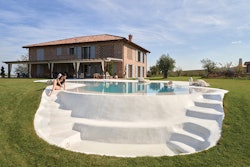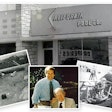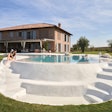
It certainly seems as if we have a good selection of products to use now, and there are talented people to rely upon for technical resources. Over the past decade-plus we’ve seen an expansion of educational resources for builders, and in many cases, projects have become more creative. Yet, for all of these advantages, many pool projects remain, shall we say, "less than visually stellar," while suffering marginal functionality compared to works generated from professionals in other design disciplines, such as landscape architects, environmental designers and artists. Why?
I believe the answer is twofold: 1) minimal education in the design disciplines and 2) most pool professionals use no systematic design process. Sometimes there are no designs at all!
For the most part, pool professionals tackle every project the same way they did all of their previous ones. Such design ruts might entail putting fire urns on the bond beam and shooting laminar water over them, piling artificial rocks at one end of a multi-radius vessel and calling it a lagoon pool, or turning to the ubiquitous vanishing edge to signal some form of thoughtful design. For far too many of our peers, this is now considered "great design," no matter how inappropriate the setting may be for these features. We have been taught that the more "things" you add to your project, the greater the design.
I argue that this boils down to product-based design, flat out. As has been the case for as long as pools have been built, cliché and shopworn features are used to replace genuine creativity.
What do "aquatic designers" do differently than "pool builders?" For starters, they practice artisan-based design before product-based design, meaning they seek inspiration in an artistic and visual realm before they open product catalogs for ideas. They also stay true to the vision of the original design, not letting profit and ease of construction sway their visual-based directions for their projects.
What’s needed is for the pool industry to migrate toward what I call an "Aqua Architecture" mentality. It’s a design-first approach that could potentially put aquatic designers on the same level as other professions and ultimately stoke demand as superior designs are sought out by end-users. Nowadays, discerning clients seek a designer to design pools and a builder to build them, but that can change.
Enter the Aqua Architect.
Some professionals work for only money, and even some seek fame. An Aqua Architect works to simply create beautiful water environments. Those other things (profit, etc.) come in time when you are good at what you do. Aqua Architecture is much more about art and inspiration. It’s about recognizing there is something wondrously beautiful in that split second when inspiration is developed into physical form.
Aqua Architects conceptualize and then sculpt with their spirit/mind, taking an idea and forming it into a physical space, like the ceramist’s clay on a pottery wheel. And make no mistake, creating beauty is not only holistic and emotionally rewarding, it can and should be financially supportive in allowing us to continue this addictive process.
Aqua Architecture is where our humanity and our intellect collide and shape our dreams into beautiful watery environments.
Over a decade ago I had a discussion with associate and close friend Eric Herman, of AQUA Magazine, concerning the future of our industry. I had humorously conceptualized the ultimate Aqua Architect. The visualization was of a professional role and status that did not exist, but I knew it could. I also had a pretty good idea of the qualities that such a professional needed to have.
My proposal to Eric was of a design professional, just like any other architectural designer, such as for buildings, landscapes or regional planning. These techniques were nothing new to me being a licensed landscape architect, but for some reason they were rarely applied to water elements.
Over the years, Eric has done his part in support of this concept through his work as editor of WaterShapes Magazine, a post he held for 12 years, and most recently in his role with AQUA, and it’s no coincidence that he’s behind the content in the magazine in a section titled AQUA Architecture.
As a result of our formative discussions, this newly conceptualized professional became a fictitious entity, one that I wrote about in dozens of magazine articles over the last 15 years. It was the source of my fuel and a point toward which I worked in my instruction, writings, design and construction. In my firm, Holdenwater, it was both my professional guilty conscience and my professional ideal.
Throughout this ongoing blog, I will reference this character, the ultimate Aqua Architect, as an industry paragon — a person to whose level of professional excellence we can all aspire.
With enough perseverance, study and development, anyone can reach this stage of achievement.
Above, I mentioned two things that are lacking in our industry: education and a process for design. By outlining what these crucial endeavors may involve, I hope to change the perception of what water-based design actually is.
One of the most prevalent complaints about higher education in the water industry is, “Why would we want to take classes on engineering, history or theory of design?” Using the Aqua Architect model, I hope to answer that question and help illuminate the trail we all must take to lift our industry.
Mark Holden is an award-winning landscape architect, pool/landscape contractor, writer and an instructor at Cal Poly University Pomona, Santa Chiara (Italy) and UCLA. He is founder of Artistic Resources & Training (ART), and has taught in the water industry for almost two decades. His firm, Holdenwater, based in Southern California and Texas, specializes in assisting other professionals in the design of water environments for a wide range of projects internationally.







































